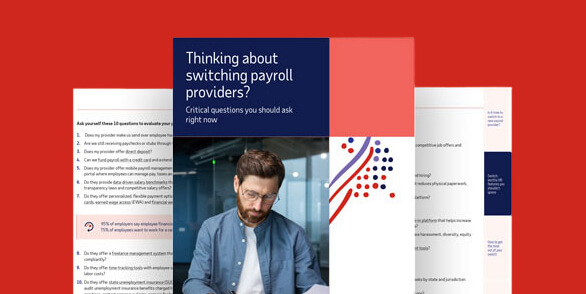How much are your employees’ wages after taxes? This powerful tool does all the gross-to-net calculations to estimate take-home pay in all 50 states. For more information, see our salary paycheck calculator guide.
Looking for managed Payroll and benefits for your business?
Important note on the salary paycheck calculator: The calculator on this page is provided through the ADP Employer Resource Center and is designed to provide general guidance and estimates. It should not be relied upon to calculate exact taxes, payroll or other financial data. These calculators are not intended to provide tax or legal advice and do not represent any ADP service or solution. You should refer to a professional advisor or accountant regarding any specific requirements or concerns.
Salary paycheck calculator guide
Although our salary paycheck calculator does much of the heavy lifting, it may be helpful to take a closer look at a few of the calculations that are essential to payroll.
How to calculate net income
- Determine taxable income by deducting any pre-tax contributions to benefits
- Withhold all applicable taxes (federal, state and local)
- Deduct any post-tax contributions to benefits
- Garnish wages, if necessary
- The result is net income
How to calculate annual income
To calculate an annual salary, multiply the gross pay (before tax deductions) by the number of pay periods per year. For example, if an employee earns $1,500 per week, the individual’s annual income would be 1,500 x 52 = $78,000.
How to calculate taxes taken out of a paycheck
- Refer to employee withholding certificates and current tax brackets to calculate federal income tax
- Calculate Federal Insurance Contribution Act (FICA) taxes using the latest rates for Medicare and Social Security
- Determine if state income tax and other state and local taxes and withholdings apply
- Divide the sum of all applicable taxes by the employee’s gross pay
- The result is the percentage of taxes deducted from a paycheck
Calculations, however, are just one piece of the larger paycheck picture.
What is a paycheck?
A paycheck is how businesses compensate employees for their work. The most common delivery schedules are bi-weekly and semi-monthly, though this varies based on employer preferences and applicable state laws and regulations. Business-specific requirements, such as collective bargaining agreements covering union employees, may also dictate paycheck frequency.
Types of paychecks
Traditionally, employees received printed checks in person or by mail, but more often today, the money is electronically deposited into a bank account. Some employers may also offer optional alternatives to paychecks, such as paycards, which can be advantageous to unbanked workers.
How to read a paycheck
Unlike withholding certificates and other employment documents, paychecks are pretty easy to decipher. Reading them is simply a matter of making sure the payment information is correct.
Information found on a paycheck:
- Check number
- Employer’s name and address
- Employee’s name and address
- Check date
- Payment amount
- Employer’s bank account and routing numbers
- Check memo (optional)
Information found on a pay stub
Most states require employees to receive pay stubs. They’re typically provided with paychecks and list details such as:
- Pay period start and end date
- Hours worked
- Gross pay
- Net or take home pay
- Federal and state income taxes
- Local taxes
- Medicare and Social Security taxes
- Deductions for benefits
- Wage garnishments
- Year-to-date totals
- Paid time off (PTO) balances
Actual pay stubs vary based on individual circumstances and the state. Some have specific requirements about the information that has to be included on the pay statement and when it must be delivered to employees.
Understanding paychecks: Withholdings and deductions
When reviewing their first paycheck, those who are new to the workforce may wonder why their take home pay is less than their gross pay. The reason is because of taxes, withholdings and deductions such as these:
Federal income tax withholding
Employers withhold federal income tax from their workers’ pay based on current tax rates and Form W-4, Employee Withholding Certificates. When completing this form, employees typically need to provide their filing status and note if they are claiming any dependents, work multiple jobs or have a spouse who also works (for married filing jointly purposes), or have any other necessary adjustments.
FICA withholding
FICA is a two-part tax. Both employees and employers pay 1.45% for Medicare and 6.2% for Social Security. The latter has a wage base limit of $176,100, which means that after employees earn that much, the tax is no longer deducted from their earnings for the rest of the year. Those with high income may also be subject to Additional Medicare tax, which is 0.9%, paid for only by the employee, not the employer.
State and local tax withholding
State and local taxes vary greatly by geographic region, with some charging much more than others. Examples include:
- State and local income tax
- State unemployment tax (SUTA)
- Short-term disability
- Paid family medical leave
Benefit deductions
Businesses that offer health insurance, dental insurance, retirement savings plans and other benefits often share the cost with their employees and withhold it from their pay. Depending on the type of benefit and the regulations that apply to it, the deduction may be pretax or post-tax. Pretax is more advantageous to employees because it lowers the individual’s taxable income.
Wage garnishments
Employers may need to deduct garnishments from employee wages if they receive a court order to do so. This can occur if an employee defaults on a loan, has unpaid taxes or is required to pay child support or alimony.
Frequently asked questions about paychecks
Is a pay stub the same as a paycheck?
Although paychecks and pay stubs are generally provided together, they are not one in the same. A paycheck is a directive to a financial institution that approves the transfer of funds from the employer to the employee. A pay stub, on the other hand, has no monetary value and is simply an explanatory document.
What should a pay stub look like?
Pay stubs generally show how an employee’s income for a particular pay period was derived, along with line items of the taxes withheld, voluntary deductions and any other benefits received. Further specifics may be required by state or local governments.
What should you do with your paycheck stub?
Pay stubs are used to verify payment accuracy and may be necessary when settling wage/hour disputes. For this reason, employees may want to save their pay stubs, but aren’t required to do so. Employers, however, must keep payroll records for the specific lengths of time mandated by federal and state governments.
What should you do if you don't receive your paycheck or your paycheck is late?
The course of action depends on the reason for the missed or late paycheck. Honest mistakes can usually be addressed by contacting the employer’s HR department.
How do I create a paycheck for an employee?
Employers typically have two basic options for creating paychecks:
- Order check stock from an office supply store or the bank that has the business payroll account and print the checks each pay period.
- Work with a payroll service provider. Some offer packages that include check signing and stuffing done on the employer’s behalf.




